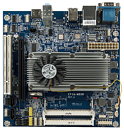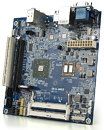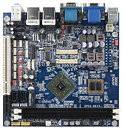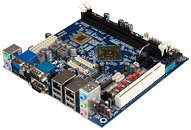Thursday, February 23rd 2012

VIA Announces World's First Quad Core Mini-ITX Boards
VIA Technologies, Inc, a leading innovator of power efficient x86 processor platforms, today announced the world's first quad core Mini-ITX boards featuring the latest VIA QuadCore E-Series processor. The VIA EPIA-M900 and VIA EPIA-M910 are the first two Mini-ITX boards to feature the 1.2 GHz VIA QuadCore E-Series processor, offering enhanced multi-tasking and superb multimedia performance on the lowest quad core power budget for next generation embedded products.
The VIA QuadCore E-Series processor features a highly optimized, energy efficient multi-core architecture, which is natively 64-bit compatible and comes with a host of additional performance features including Adaptive Overclocking. To meet the low power demands of the embedded market, the VIA QuadCore E-Series processor offers industry-leading energy efficiency, with the VIA QuadCore E-Series 1.2+ GHz processor delivering a thermal design power (TDP) of only 27.5 W. The distributed power of the VIA QuadCore E-Series processor makes it ideal for handling the most demanding HD video formats for immersive multi-display applications and environments."The VIA QuadCore E-Series processor delivers world class performance in the industry's leading power efficient package," said Epan Wu, Head of the VIA Embedded Platform Division, VIA Technologies, Inc. "The high performance of the VIA QuadCore E-Series processor makes it the perfect platform for the creation of next generation digital signage displays and embedded projects."
VIA EPIA-M900
Measuring 17 cm x 17 cm the VIA EPIA-M900 Mini-ITX board features the choice of a 1.2 GHz VIA QuadCore E-Series processor or a 1.6 GHz dual core VIA Nano X2 E-Series processor. Paired with the VIA VX900 MSP, supporting up to 8 GB of DDR3 system memory and featuring the VIA ChromotionHD 2.0 video processor, the VIA EPIA-M900 enables the creation of a wealth of innovative next generation digital signage, POS, Kiosk, ATM, home automation, healthcare and media client system design applications.
Rear panel I/O includes a Gigabit LAN port, HDMI port, VGA port, four USB 2.0 ports, one COM port and three audio jacks. An onboard PCIe x16 slot (with effective speed up to PCIe x8) and one PCI slot is accompanied with pin headers providing one dual channel 24-bit LVDS support (including backlight control), an additional three COM ports, a further four USB 2.0 ports and one USB device port, LPC support, 2 Digital I/O, SPDIF out and an SMBus header.
For more information about the VIA EPIA-M900 Mini-ITX board, please visit:
www.viaembedded.com/en/products/boards/productDetail.jsp?productLine=1&id=1550&tabs=1
VIA EPIA-M910
Paired with the VIA VX900 MSP, the VIA EPIA-M910 is available with a wide choice of VIA x86 processors, including the latest 1.2 GHz VIA QuadCore E-Series processor, a 1.6 GHz VIA Nano X2 dual core processor or a fanless 1.0 GHz VIA Eden X2 dual core processor. Featuring one of the richest I/O sets available, the VIA EPIA-M910 is ideal for a wide range of embedded applications including ATM, kiosks, POS, digital signage, healthcare and digital media applications.
Rear panel I/O includes dual Gigabit LAN ports, PS/2 support, one HDMI port, a VGA port, two RS-232 5v/12v selectable COM ports, four USB 2.0 ports and audio jacks. On board pin headers provide 2 x 24-bit LVDS support (including backlight control), two SATA ports, an additional six COM ports, a further four USB ports, Digital I/O, and a PCIe x4 slot. The VIA EPIA-M910 is available with support for either ATX or DC-in power supplies.
For more information about the VIA EPIA-M910 Mini-ITX board, please visit:
www.viaembedded.com/en/products/boards/productDetail.jsp?productLine=1&id=1810&tabs=1
The VIA QuadCore E-Series processor features a highly optimized, energy efficient multi-core architecture, which is natively 64-bit compatible and comes with a host of additional performance features including Adaptive Overclocking. To meet the low power demands of the embedded market, the VIA QuadCore E-Series processor offers industry-leading energy efficiency, with the VIA QuadCore E-Series 1.2+ GHz processor delivering a thermal design power (TDP) of only 27.5 W. The distributed power of the VIA QuadCore E-Series processor makes it ideal for handling the most demanding HD video formats for immersive multi-display applications and environments."The VIA QuadCore E-Series processor delivers world class performance in the industry's leading power efficient package," said Epan Wu, Head of the VIA Embedded Platform Division, VIA Technologies, Inc. "The high performance of the VIA QuadCore E-Series processor makes it the perfect platform for the creation of next generation digital signage displays and embedded projects."
VIA EPIA-M900
Measuring 17 cm x 17 cm the VIA EPIA-M900 Mini-ITX board features the choice of a 1.2 GHz VIA QuadCore E-Series processor or a 1.6 GHz dual core VIA Nano X2 E-Series processor. Paired with the VIA VX900 MSP, supporting up to 8 GB of DDR3 system memory and featuring the VIA ChromotionHD 2.0 video processor, the VIA EPIA-M900 enables the creation of a wealth of innovative next generation digital signage, POS, Kiosk, ATM, home automation, healthcare and media client system design applications.
Rear panel I/O includes a Gigabit LAN port, HDMI port, VGA port, four USB 2.0 ports, one COM port and three audio jacks. An onboard PCIe x16 slot (with effective speed up to PCIe x8) and one PCI slot is accompanied with pin headers providing one dual channel 24-bit LVDS support (including backlight control), an additional three COM ports, a further four USB 2.0 ports and one USB device port, LPC support, 2 Digital I/O, SPDIF out and an SMBus header.
For more information about the VIA EPIA-M900 Mini-ITX board, please visit:
www.viaembedded.com/en/products/boards/productDetail.jsp?productLine=1&id=1550&tabs=1
VIA EPIA-M910
Paired with the VIA VX900 MSP, the VIA EPIA-M910 is available with a wide choice of VIA x86 processors, including the latest 1.2 GHz VIA QuadCore E-Series processor, a 1.6 GHz VIA Nano X2 dual core processor or a fanless 1.0 GHz VIA Eden X2 dual core processor. Featuring one of the richest I/O sets available, the VIA EPIA-M910 is ideal for a wide range of embedded applications including ATM, kiosks, POS, digital signage, healthcare and digital media applications.
Rear panel I/O includes dual Gigabit LAN ports, PS/2 support, one HDMI port, a VGA port, two RS-232 5v/12v selectable COM ports, four USB 2.0 ports and audio jacks. On board pin headers provide 2 x 24-bit LVDS support (including backlight control), two SATA ports, an additional six COM ports, a further four USB ports, Digital I/O, and a PCIe x4 slot. The VIA EPIA-M910 is available with support for either ATX or DC-in power supplies.
For more information about the VIA EPIA-M910 Mini-ITX board, please visit:
www.viaembedded.com/en/products/boards/productDetail.jsp?productLine=1&id=1810&tabs=1




5 Comments on VIA Announces World's First Quad Core Mini-ITX Boards
I'm sure some businesses can find perfect use for these two boards.
About the small fan: it's not bc $40 videocards use very low end small fans (that break very fast) that they are inherently bad by design. I've seen Quadro's with very small fans run for many years with a hitch. I use a Scythe 4cm fan for many years and it's still perfectly silent.